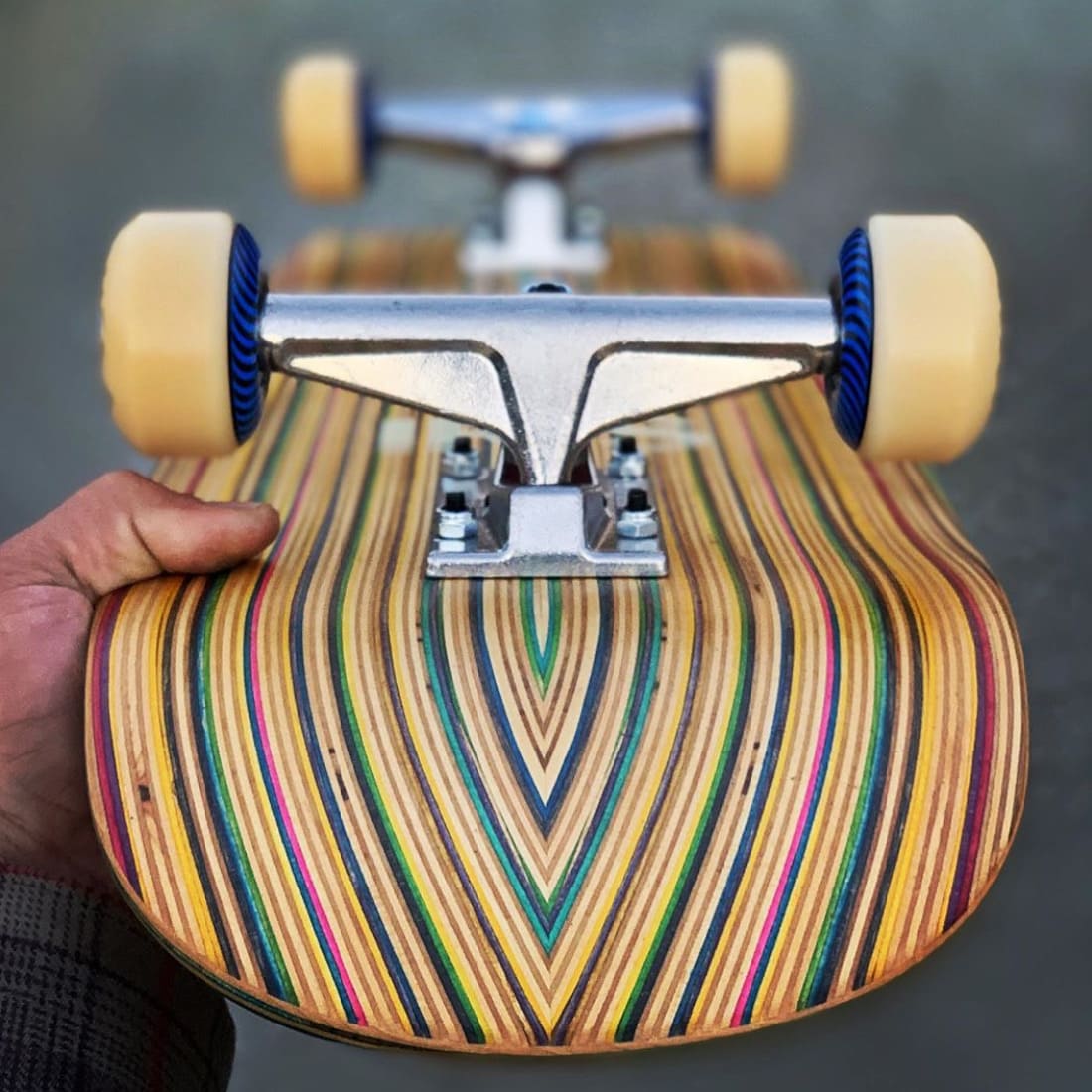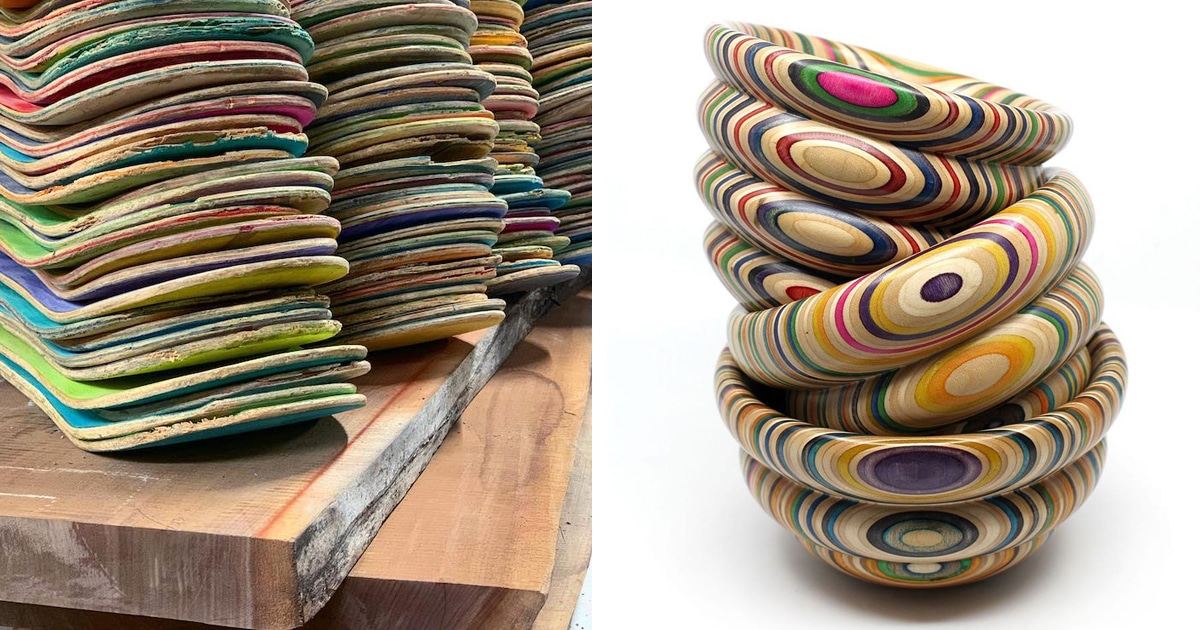You know what's been bothering me lately? Last month I was walking through Berlin's Tiergarten, and I started thinking about all the maple trees that get cut down to make traditional skateboard decks. Don't get me wrong - I love working with premium materials at DeckArts, but there's this growing voice in my head asking: "Can we do this more sustainably?"
Actually, it wasn't just the trees that got me thinking. It was a conversation with this environmental science student who visited our studio. She was genuinely excited about our Botticelli's Birth of Venus Skateboard Wall Art, but then she asked about our production methods. And honestly? I didn't have great answers about our environmental impact.
That conversation changed everything for me. Since then, I've been diving deep into sustainable materials and eco-friendly production methods for skateboard art. What I've discovered is pretty exciting - and sometimes surprising.
The Hidden Environmental Cost of Traditional Skateboard Production
Here's something most people don't realize about conventional skateboard manufacturing: it's pretty resource-intensive. Traditional decks use 7-ply Canadian maple, which means harvesting old-growth forests. The adhesives contain formaldehyde and other chemicals. The printing processes often use solvent-based inks that release volatile organic compounds (VOCs) into the atmosphere.
When I was researching this for DeckArts, I found out that producing a single traditional skateboard deck generates roughly 3.2 kg of CO2 emissions. That includes timber harvesting, processing, adhesives, shipping... the whole lifecycle. For a company like ours that focuses on wall art rather than functional skateboards, that environmental footprint started feeling pretty heavy.
But here's the good news - sustainable alternatives are getting better every year. Companies like Bamboo Skateboards have been pioneering eco-friendly materials that actually perform better than traditional maple in many ways. And the printing technologies? They've evolved dramatically.
I wrote about some related environmental considerations in my Small Spaces, Big Impact: Skateboard Decor for Urban Apartments article, where sustainable choices become even more important in densely populated urban areas.

Bamboo: The Game-Changing Sustainable Material
So bamboo turned out to be this incredible revelation. I mean, I knew it was used for flooring and furniture, but skateboard decks? The more I researched, the more impressed I became.
Bamboo grows 30 times faster than maple trees. It's technically a grass, so harvesting it doesn't kill the plant - it just grows back stronger. No replanting needed, no decades of waiting for maturity. And the strength-to-weight ratio? Actually superior to traditional maple in most applications.
From a production standpoint, bamboo requires significantly less processing. The natural lamination structure means fewer adhesives, and the fiber orientation provides excellent flexibility and pop. For skateboard wall art, bamboo also has this gorgeous natural grain pattern that can enhance classical artwork reproduction in ways maple never could.
The environmental numbers are impressive too. Bamboo cultivation actually improves soil quality and prevents erosion. It absorbs more CO2 than traditional trees during growth, and the processing requires about 60% less energy than maple deck production.
Reclaimed and Recycled Wood Alternatives
Another approach that's gaining traction is using reclaimed wood from various sources. I've seen beautiful skateboard art created from old furniture, construction waste, even decommissioned skate ramps. The character you get from aged wood can add incredible depth to art reproduction.
Our Caravaggio Medusa Skateboard Wall Art would look absolutely stunning on reclaimed oak or cherry - the weathered texture would complement Caravaggio's dramatic style perfectly. But sourcing consistent quality reclaimed wood is challenging, which is why it's still more of a boutique option than a mass production solution.
There's also fascinating work being done with recycled plastic lumber and composite materials. Companies are creating skateboard decks from ocean plastic waste, old bottles, even recycled rubber. The performance isn't quite there for serious skating, but for wall art applications, these materials offer unique aesthetic possibilities.
Sustainable Printing Technologies Revolution
This is where things get really interesting from a technical perspective. Traditional screen printing uses solvent-based inks that release harmful VOCs and require toxic cleaning solvents. But water-based and soy-based ink technologies have advanced dramatically in recent years.
Water-based inks eliminate virtually all VOC emissions and provide incredibly vibrant colors. The curing process uses less energy, and cleanup requires only water instead of harsh chemicals. For reproducing classical art on skateboard decks, water-based inks can actually achieve better color accuracy and longevity than traditional methods.
UV-curing inks represent another breakthrough. They cure instantly under UV light with zero solvent emissions, use less energy overall, and create incredibly durable finishes. Perfect for skateboard wall art that needs to maintain its visual impact over years of display.
I explored some of these technical considerations in my Skateboard Art Maintenance: Preserving Your Investment Over Time guide, where sustainable production methods actually contribute to longer-lasting pieces.

Digital Printing: Less Waste, More Precision
One of the biggest advantages of digital printing for sustainable skateboard art is the elimination of setup waste. Traditional screen printing requires test runs, color matching samples, and inevitably produces defective pieces. With digital printing, you print exactly what you need, when you need it.
Digital systems also enable precise color management, which means less ink waste and more consistent results. For classical art reproduction, this precision is crucial - you want those Renaissance colors to be as accurate as possible, whether you're printing one piece or a hundred.
The ability to print on-demand also reduces inventory waste. Instead of producing large runs and hoping they sell, sustainable skateboard art production can respond directly to customer demand. Less overproduction, fewer unsold pieces ending up in landfills.
Bio-Based Adhesives and Finishes
Traditional skateboard construction uses formaldehyde-based adhesives and lacquer finishes that continue releasing chemicals for years after production. But bio-based alternatives are becoming genuinely competitive.
Soy-based and plant-derived adhesives provide excellent bonding strength without the toxic emissions. Natural wax and plant-oil finishes protect the wood while allowing it to breathe naturally. For bamboo decks especially, these natural finishes complement the material's inherent sustainability.
The durability is actually better in many cases. Natural finishes can be refreshed and maintained rather than requiring complete refinishing. And when the piece eventually reaches end-of-life, bio-based materials biodegrade instead of persisting in landfills.
Local Sourcing and Production Networks
One aspect of sustainability that doesn't get enough attention is transportation emissions. Shipping skateboard decks from overseas production facilities contributes significantly to their carbon footprint.
That's why I'm seeing increasing interest in regional production networks. Bamboo can be grown in Europe now (climate change has its weird benefits, I guess). Local printing facilities reduce shipping distances. Regional finishing and assembly operations create more sustainable supply chains.
For DeckArts, this means exploring partnerships with European bamboo suppliers and local finishing facilities. Our Bosch Garden of Earthly Delights Skateboard Deck Triptych could be produced entirely within a 500-kilometer radius of Berlin. That's exciting from both sustainability and quality control perspectives.
The Economics of Sustainable Production
Here's the reality check: sustainable materials and processes often cost more upfront. Bamboo decks typically run 20-30% higher than maple. Water-based inks cost more than solvent-based alternatives. Bio-based adhesives have higher material costs.
But the lifecycle economics tell a different story. Sustainable materials often last longer, require less maintenance, and retain value better. Customers are increasingly willing to pay premiums for environmentally responsible products. And production costs for sustainable materials are dropping as demand increases.
From a business perspective, sustainability is becoming a competitive advantage rather than just a cost center. Especially in markets like Germany, where environmental consciousness influences purchasing decisions significantly.

Certification and Standards
One challenge in sustainable skateboard production is the lack of standardized environmental certifications. Unlike other industries, there isn't a widely recognized eco-label system for skateboard products.
However, existing certification systems like FSC (Forest Stewardship Council) for wood products, Cradle to Cradle for material health, and various organic/bio-based certifications can apply to skateboard components. As the industry matures, I expect we'll see skateboard-specific sustainability standards emerge.
For now, transparency is key. Documenting material sources, production methods, and environmental impact data lets customers make informed decisions. At DeckArts, we're working toward complete supply chain transparency - from raw materials to finished pieces.
Consumer Awareness and Demand
What's really driving the sustainable skateboard movement is changing consumer attitudes, especially among younger demographics. Gen Z customers actively seek out environmentally responsible products and are willing to pay premiums for them.
This shift is particularly strong in the skateboard wall art market, where customers are making longer-term decorative investments. They want pieces that align with their values, not just their aesthetic preferences.
The educational aspect is crucial too. Most customers don't understand the environmental impact of traditional skateboard production until it's explained to them. Once they learn about the alternatives, the choice becomes obvious for many people.
Future Innovations on the Horizon
The most exciting developments are still in research and development phases. Mycelium-based materials (grown from mushroom roots) could eventually replace wood entirely. Algae-based inks and biodegradable printing substrates are being tested. Even more advanced bio-composite materials that combine multiple sustainable inputs.
3D printing with sustainable materials is another frontier. Imagine being able to print custom skateboard shapes on-demand using recycled ocean plastic or bio-based polymers. The customization possibilities would be incredible, and the environmental impact minimal.
Carbon-negative materials are the ultimate goal - materials that actually sequester more carbon during production than they release over their lifecycle. Some bamboo cultivation methods are already approaching carbon neutrality, and emerging bio-engineering techniques could push beyond that.
Making the Transition at DeckArts
So where does this leave us practically? At DeckArts, we're committed to transitioning toward sustainable production methods without compromising the quality that classical art reproduction demands.
Phase one involves switching to water-based inks for all new productions. The color accuracy is actually better for Renaissance art reproduction, and eliminating VOC emissions aligns with our Berlin location's environmental standards.
Phase two explores bamboo and reclaimed wood options for select pieces. Not every classical artwork will look right on bamboo, but pieces like our forest or nature-themed reproductions could be stunning on sustainable materials.
Phase three involves developing local supply chains and production partnerships that minimize transportation emissions while maintaining quality control.
The Collector's Perspective on Sustainable Art
From talking with collectors, I'm seeing genuine enthusiasm for sustainable skateboard art that doesn't sacrifice aesthetic quality. Many view environmental responsibility as adding value to their collections rather than limiting their options.
There's also growing interest in the story behind sustainable pieces - the material sourcing, production methods, environmental impact data. Collectors want to understand and share the full narrative of their pieces, not just the artistic content.
Actually, this this storytelling aspect connects back to my The Underground Art Movement That Inspired DeckArts article, where the cultural context and production story become part of the artistic value.
About the Author
Stanislav Arnautov is the founder of DeckArts and a creative director originally from Ukraine, now based in Berlin. With extensive experience in branding, merchandise design, and vector graphics, Stanislav has worked with Ukrainian streetwear brands and organized art events for Red Bull Ukraine. His unique expertise combines classical art knowledge with modern design sensibilities, creating museum-quality skateboard art that bridges Renaissance masterpieces with contemporary culture. Follow him on Instagram, visit his personal website stasarnautov.com, or check out DeckArts on Instagram and explore the curated collection at DeckArts.com.

